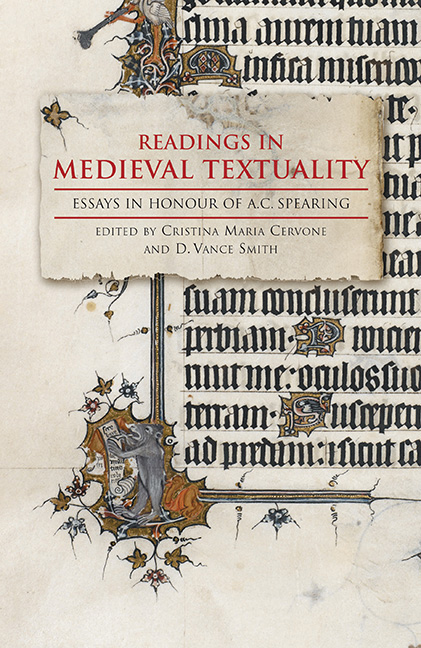Book contents
- Frontmatter
- Contents
- List of Illustrations
- List of Contributors
- A. C. Spearing's Work and Influence
- Bibliography of A. C. Spearing's Works
- I Reading Experience and Experientiality
- II Revisions and Re-visioning of Alliterative Poetry
- III Subjectivity and the Self
- IV Reading for Form
- 8 The Inescapability of Form
- 9 Destroyer of Forms: Chaucer's Philomela
- 10 Gower's Confessio Amantis and Chaucer's Canterbury Tales as Dits
- 11 Poems without Form? Maiden in the mor lay Revisited
- 12 “I” and “We” in Chaucer's Complaint unto Cervone Pity
- V Epilogue
- Works Cited
- Index
- Tabula Gratulatoria
11 - Poems without Form? Maiden in the mor lay Revisited
from IV - Reading for Form
Published online by Cambridge University Press: 25 October 2017
- Frontmatter
- Contents
- List of Illustrations
- List of Contributors
- A. C. Spearing's Work and Influence
- Bibliography of A. C. Spearing's Works
- I Reading Experience and Experientiality
- II Revisions and Re-visioning of Alliterative Poetry
- III Subjectivity and the Self
- IV Reading for Form
- 8 The Inescapability of Form
- 9 Destroyer of Forms: Chaucer's Philomela
- 10 Gower's Confessio Amantis and Chaucer's Canterbury Tales as Dits
- 11 Poems without Form? Maiden in the mor lay Revisited
- 12 “I” and “We” in Chaucer's Complaint unto Cervone Pity
- V Epilogue
- Works Cited
- Index
- Tabula Gratulatoria
Summary
“Enchanting” is the word used by Peter Dronke of this much anthologized ballad- like song:
Maiden in the mor lay,
In the mor lay;
Sevenight fulle,
Sevenight fulle,
Maiden in the mor lay,
In the mor lay,
Sevenightes fulle and a day.
Welle was hire mete.
What was hire mete?
The primerole and the –
The primerole and the –
Welle was hire mete.
What was hire mete?
The primerole and the violet.
Welle was hire dring.
What was hire dring?
The chelde water of the –
The chelde water of the –
Welle was hire dring.
What was hire dring?
The chelde water of the welle-spring.
Welle was hire bowr.
What was hire bowr?
The rede rose and the –
The rede rose and the –
Welle was hire bowr.
What was hire bowr?
The rede rose and the lilye flour.
His reading declares the “maiden” a water sprite from German folksong, a creature who appears mysteriously “at village dances in the guise of a beautiful human girl” and then at an appointed time returns to the moor where she feeds on flowers and drinks the water from a spring. Perhaps, says Dronke, writing with his typical passion and imagination, this English song represents a mime with the girl playing queen of the dance while her admirers offer her food and drink before she vanishes.
Anyone who has followed the fortunes of this song will know that it became an icon of mid-twentieth-century attempts to “negotiate the past.” Caught between the Scylla of Robertsonian exegesis and the Charybdis of Donaldsonian New Criticism, the maiden found herself metamorphosing back and forth from sprite to holy virgin. Less conspicuously, another metamorphosis was taking place. In each reprinting, in each new anthology, the maiden was set within a fresh text: there are some twenty editions. Yet the controversy of the poem's textual form has attracted far less attention than the battle over its sacred or secular meaning. This essay, in homage to perhaps the first and best New Critic of medieval literature, will offer an exegesis, not of the poem's spirituality but of its “living form.”
The Maiden in the manuscript
Our first and last recourse is the unique manuscript.
- Type
- Chapter
- Information
- Readings in Medieval TextualityEssays in Honour of A.C. Spearing, pp. 169 - 194Publisher: Boydell & BrewerPrint publication year: 2016

